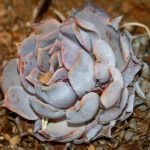The Echeveria Elegans, is a species of succulent plant (or crasa) belonging to the family of crassula .
It is native to Central America, Mexico, more exactly the State of Hidalgo, northwest of Mexico.
These areas, characterized by having strong weather variations between day and night and is very widespread.

It is highly esteemed as an ornamental plant, for its beauty and ease of cultivation.
There are more than 150 species of Echeverias and all are native to Mexico.
Common name : Mexican Snowball .
Table of Contents
What does Crassas or Succulents mean?
They are those species, capable of storing water reserves in their tissues, so that they can withstand periods of drought.
Of these, cactaceae stand out for their resistance to aridity.
The plants of the genus Echeveria , are of this type of succulents, they are not cactus but they store water.
Description of Echeveria Elegans.
The Echeveria Elegans, is a small plant, crasa or succulents without stems, which come to form rosettes about 8 cm in diameter.
Its leaves are fleshy and have a bluish color with whitish edges, the color is varied, from intense green to pale blue, to blue-gray, to pinkish green and arranged in the shape of an artichoke.

They produce pink stems between 15 cm and 20 cm in height, from which the rosettes often cast pink and yellow flowers.
They flower from late winter to late spring.
Many varieties, over the years, come to form logs of more than 60 cm in height.
They are located on clusters of 10 cm to 25 cm in length and inclined to the side.
The Alabaster Rose or Echeveria Elegans, is a long-lived, can live up to 7 years.
They have a large water reserve and the range of colors ranges from green or bluish greens to very dark reds, almost black, to bicolor varieties.
How and where does Echeveria Elegans look best?
One of the most widespread uses is to cover or quilt small surfaces, in seedlings or in pots .
They are suitable for coastal gardens and large cities for their tolerance to pollution.
Keep in mind that its growth is rather slow.
The Alabaster Rose or Echeveria Elegans, is a good option to plant anywhere in the garden.
It adapts easily to any terrain and does not need much care, as long as the soil has good drainage.
It is the Echeveria Elegans, very decorative because the Echeveria is, above all, an outdoor plant.

In the garden it is great and it is perfect to cover difficult places, with little soil and little irrigation.
It is perfect to cover rockery or slope areas .
The flowers of the Echeveria Elegans.
The flowers develop on a long stem that grows from the center of the rosette.
They are usually very striking, shaped like lanterns, red or pink and with yellow margins.

It blooms from spring and throughout the summer.
Species of Echeverias.
Some of the many species of Echeveria that we can find are;






How to care for Echeveria Elegans.
Because of its crass or succulent plant condition, it seems that they do not require care and effectively require little attention.
If they are neglected, they still grow, but they would do better if we paid them due attention, which is not too much.
The cares are necessary, they can vegetate better and not simply survive.
So, if we give these plants the necessary care, they will reward us with spectacular growth.
The climatic adaptation of the Alabaster Rose wants a lot of light in all the seasons of the year and also in direct sunlight.
In the hottest hours of the summer days, it will be necessary to protect them from the direct sun.
These succulent plants, the Echeverias, have to be cultivated preferably, inside our homes.
Except in areas of the mild climate, where it does not freeze at night and lower the temperature in winter at 0ºC to the outside, although there are varieties that resist moderate frosts.
The optimum summer temperatures of culture oscillate between 15ºC to 21ºC, but they also tolerate higher temperatures.
During the winter, it is preferable that they do not fall below 7ºC.
The leaves of many species of Echeveria are covered by a dusty substance, pay attention and do not remove it
This dusty substance is Epicuticular wax a substance that protects them from dehydration.
Do not forget to eliminate the flowers and withered leaves to achieve a much more vigorous growth.
How to water the Echeveria Elegans.
Echeveria Elegans tolerates well the abundant waterings in the open air, in rock gardens and gardens.
In pots, you have to be careful with the excesses to avoid possible rottenness.
When watering, it must always be on the ground or substrate and never on the leaves, because it does not tolerate excess humidity.
Moderate watering during summer and zero or almost zero in winter.
It is recommended to water when the top 2.5 cm of the substrate is dry.
Avoid wetting the leaves. Never spray water on the plant.
A technique to be taken into account, since the plant is very compact and quickly occupies the pot, is the irrigation by immersion.
Leave the pot a few minutes in immersion in water, so that the soil absorbs the necessary moisture.

Always water, when the surface of the substrate is dry.
How should the substrate of Echeveria Elegans be?
The substrate for a good growth could be a mixture of 1/3 of sand and 2/3 of mulch of leaves.
The Echeveria Elegans can thrive in poorer soils.
It must be loose and aerated, adding washed or river sand, sandstone or similar to a universal substrate base.
The simplest thing is to get a substrate for cactus and succulents for sale, in shops to the effect.
You will see that it is very undemanding in terms of nutrients.
It is convenient to add fertilizer once in a while, it will grow and it will flourish with greater abundance.
During the spring and until autumn, which is when the plant needs it.
In the spring and summer, add once a month a fertilizer for cactus and succulents, diluted to 50%.
After flowering, put in an illuminated, aerated and fresh place, since it needs very little irrigation.
How to transplant the Echeveria Elegans.
Like all plants, it should be transplanted periodically, in the spring, if the roots have occupied all the space of the available pot.
Use a specific compost for cactus, to which you will add coarse river sand or perlite, in the one to one ratio, as they make the substrate more porous, facilitating the drainage of irrigation waters.
The drainage hole should not be obstructed so that the soil or roots do not obstruct it.
Place pebbles that avoid it, since the soil puddlings are lethal for this plant.
Better to use terracotta pots and not plastic, because the terracotta allows the soil to perspire and therefore reduce soil moisture more quickly.
The pots should be wide and not too deep since the roots grow more in width than in depth.
How to fertilize the Echeveria Elegans.
When spring and summer begins, give every fifteen or twenty days by supplying a liquid fertilizer to be diluted in the irrigation water at 50%.
Since fertilizing in autumn and winter for Echeveria excess could be harmful to the roots.
How to prune the Echeveria Elegans
The Echeveria elegans does not need pruning. Just remove the leaves that are drying as it grows, to avoid bringing diseases or pests.
The cut must be clean and the blade cleaned and disinfected.
How to multiply the Echeveria Elegans.
It is multiplied by cutting of leaves, by seeds or by suckers.
With cuttings, the multiplication of the plant is very easy by separating them, by leaves at the beginning of summer.
We will make leaf cuttings or, from the shoots that the plant itself produces by stolons.
These leaf cuttings are planted in peat and sand at 50% and warm temperature (above 16ºC) and irrigated with control, without puddling.
The leaf will wilt as the new bud forms and will be transplanted when they have an average size, treating them as adult plants.
The leaves of Echeveria Elegans most indicated to put to root, are those that are more easily detached from the stem.
For the reproduction by sprouts, in spring, on March, the growth that the plant has in the area of ??the base of the stem is removed, cutting with a sharp razor.
The cut piece is allowed to dry for at least a week, to make the wound heal.
This will be planted in a pot, with 50% peat and sand substrate.
Fertilize it monthly, but slightly.
It is also possible to multiply the Echeveria Elegans through seeds, although it is more complicated.
Towards the month of March, dividing the seeds by the substrate, as before.
They are introduced in water, until the substrate is well soaked, letting the excess water drain.
You can prepare a seedbed and cover it with transparent plastic film so that it maintains the humidity and the temperature of the substrate.
We will control the degree of humidity, avoiding excesses.
Keep them with good light, temperature above 16ºC on average and humid, until they germinate, then remove the plastic cover.
What plagues and diseases have Echeveria Elegans.
Like all succulent plants, they do not suffer from much diseases.
Control low temperatures, as well as excess water and dry debris that could cause botrytis.
They can suffer attacks of aphids and woodlice, both on the leaves and especially on the roots.



